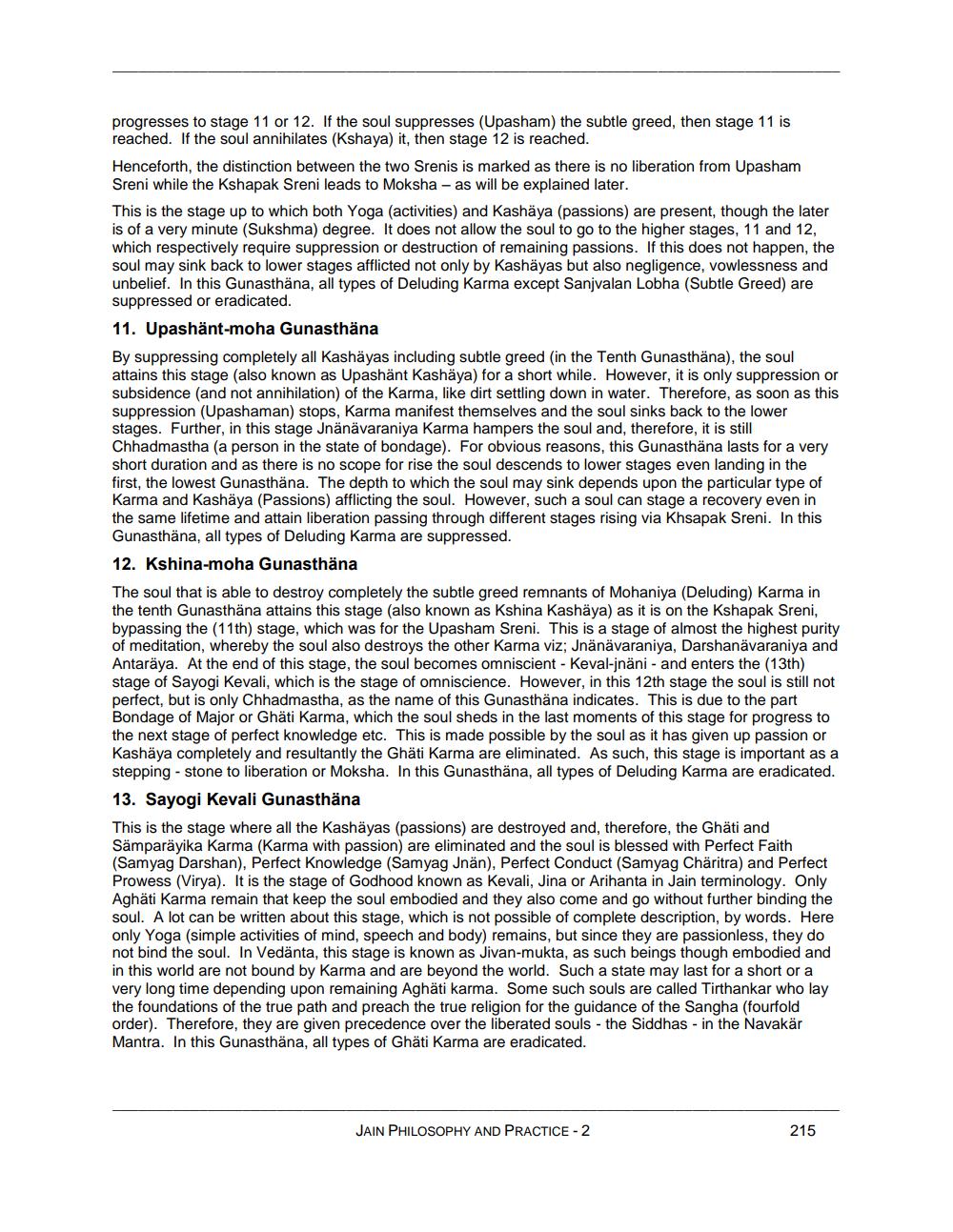________________
progresses to stage 11 or 12. If the soul suppresses (Upasham) the subtle greed, then stage 11 is reached. If the soul annihilates (Kshaya) it, then stage 12 is reached. Henceforth, the distinction between the two Srenis is marked as there is no liberation from Upasham Sreni while the Kshapak Sreni leads to Moksha -as will be explained later. This is the stage up to which both Yoga (activities) and Kashaya (passions) are present, though the later is of a very minute (Sukshma) degree. It does not allow the soul to go to the higher stages, 11 and 12, which respectively require suppression or destruction of remaining passions. If this does not happen, the soul may sink back to lower stages afflicted not only by Kashäyas but also negligence, Vowlessness and unbelief. In this Gunasthäna, all types of Deluding Karma except Sanjvalan Lobha (Subtle Greed) are suppressed or eradicated. 11. Upashänt-moha Gunasthäna
By suppressing completely all Kashayas including subtle greed (in the Tenth Gunasthäna), the soul attains this stage (also known as Upashänt Kashya) for a short while. However, it is only suppression or subsidence (and not annihilation) of the Karma, like dirt settling down in water. Therefore, as soon as this suppression (Upashaman) stops, Karma manifest themselves and the soul sinks back to the lower stages. Further, in this stage Jnänävaraniya Karma hampers the soul and, therefore, it is still Chhadmastha (a person in the state of bondage). For obvious reasons, this Gunasthäna lasts for a very short duration and as there is no scope for rise the soul descends to lower stages even landing in the first, the lowest Gunasthäna. The depth to which the soul may sink depends upon the particular type of Karma and Kashaya (Passions) afflicting the soul. However, such a soul can stage a recovery even in the same lifetime and attain liberation passing through different stages rising via Khsapak Sreni. In this Gunasthäna, all types of Deluding Karma are suppressed. 12. Kshina-moha Gunasthäna The soul that is able to destroy completely the subtle greed remnants of Mohaniya (Deluding) Karma in the tenth Gunasthäna attains this stage (also known as Kshina Kashaya) as it is on the Kshapak Sreni, bypassing the (11th) stage, which was for the Upasham Sreni. This is a stage of almost the highest purity of meditation, whereby the soul also destroys the other Karma viz; Jnänävaraniya, Darshanävaraniya and Antaräya. At the end of this stage, the soul becomes omniscient - Keval-jnäni - and enters the (13th) stage of Sayogi Kevali, which is the stage of omniscience. However, in this 12th stage the soul is still not perfect, but is only Chhadmastha, as the name of this Gunasthäna indicates. This is due to the part Bondage of Major or Ghäti Karma, which the soul sheds in the last moments of this stage for progress to the next stage of perfect knowledge etc. This is made possible by the soul as it has given up passion or Kashaya completely and resultantly the Ghäti Karma are eliminated. As such, this stage is important as a stepping - stone to liberation or Moksha. In this Gunasthäna, all types of Deluding Karma are eradicated. 13. Sayogi Kevali Gunasthana This is the stage where all the Kashayas (passions) are destroyed and, therefore, the Ghäti and Sämparäyika Karma (Karma with passion) are eliminated and the soul is blessed with Perfect Faith (Samyag Darshan), Perfect Knowledge (Samyag Jnän), Perfect Conduct (Samyag Charitra) and Perfect Prowess (Virya). It is the stage of Godhood known as Kevali, Jina or Arihanta in Jain terminology. Only Aghäti Karma remain that keep the soul embodied and they also come and go without further binding the soul. A lot can be written about this stage, which is not possible of complete description, by words. Here only Yoga (simple activities of mind, speech and body) remains, but since they are passionless, they do not bind the soul. In Vedänta, this stage is known as Jivan-mukta, as such beings though embodied and in this world are not bound by Karma and are beyond the world. Such a state may last for a short or a very long time depending upon remaining Aghäti karma. Some such souls are called Tirthankar who lay the foundations of the true path and preach the true religion for the guidance of the Sangha (fourfold order). Therefore, they are given precedence over the liberated souls - the Siddhas - in the Navakär Mantra. In this Gunasthäna, all types of Ghäti Karma are eradicated.
JAIN PHILOSOPHY AND PRACTICE - 2
215




